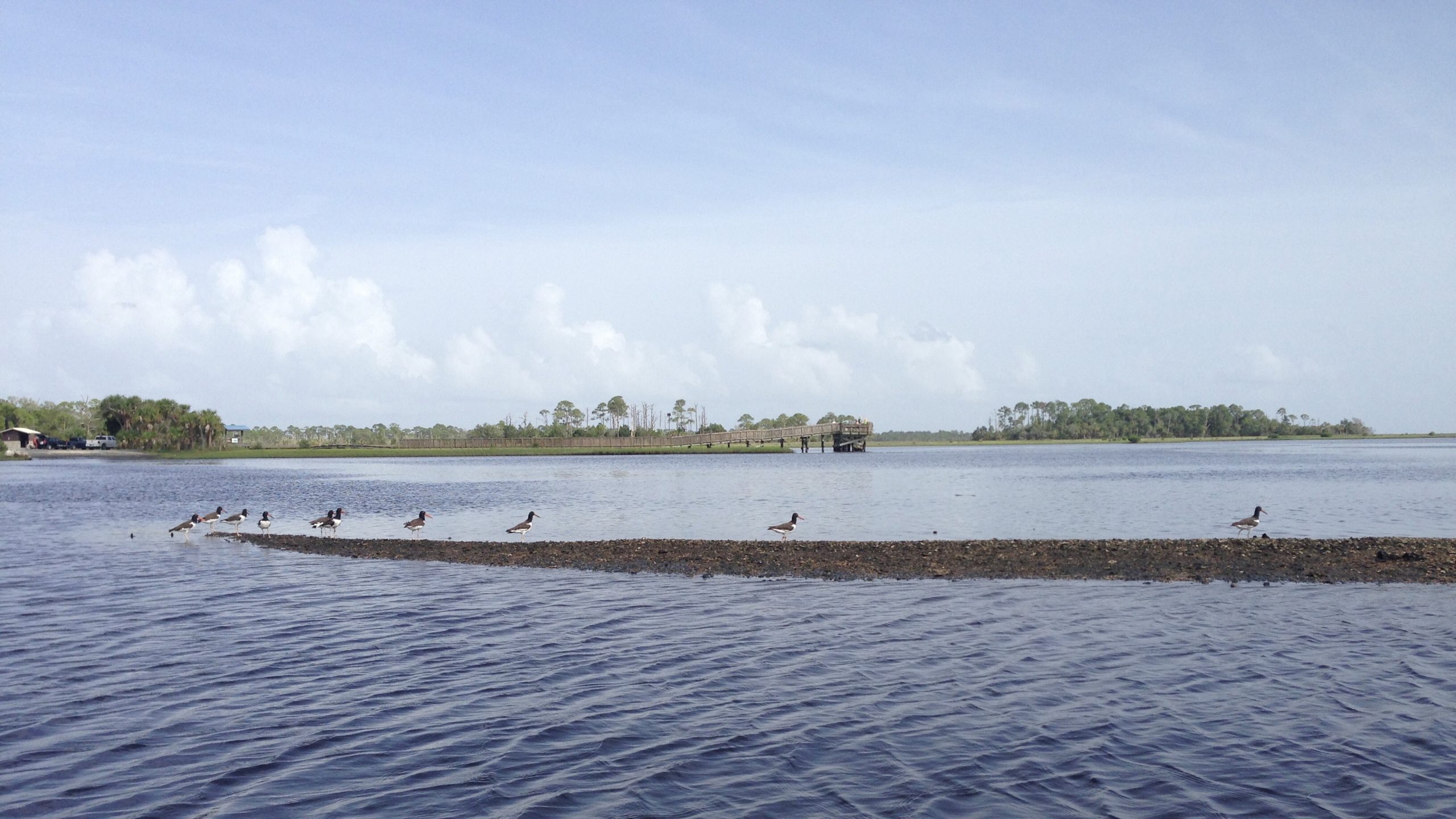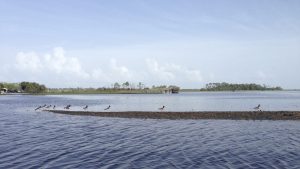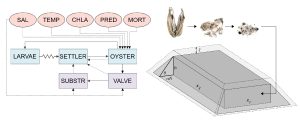SE CASC Researchers Develop Model to Support Oyster Reef Restoration Efforts

A new publication, Modeling structural mechanics of oyster reef self-organization including environmental constraints and community interactions which was authored by USGS Research Ecologist and SE CASC Researcher, Simeon Yurek, and co-authored by a team that included SE CASC Research Ecologist, Mitch Eaton was published in the journal Ecological Modelling on January 15. This work was supported by the U.S. Fish and Wildlife Service, the USGS Wetland and Aquatic Research Center, and the SE CASC funded project, Climate Change Adaptation for Coastal National Wildlife Refuges. The following post was written by SE CASC Communications Specialist, Ashlyn Shore.

A multi-agency team of researchers developed a modeling tool that supports oyster reef restoration decision making by simulating and predicting complex reef-building processes of oysters under varying environmental and ecological conditions – processes that determine important ecosystem services provided by reef restorations such as living shorelines.
The focus of this study was on the self-organization process of reef systems built by the Eastern oyster (Crassostrea virginica), an organism native to the Atlantic and Gulf coasts of the United States. The process of self-organization relies on a balance between internal population dynamics and external factors. The calcareous shell substrate that provides a structural foundation for the reef is produced by individual oysters and is maintained by further recruitment of oyster larvae back to the reef, resulting in coupled dynamics. The reef interacts with external conditions, including hydrodynamics, wave energy, food availability, predation, sedimentation, and water quality conditions of temperature and salinity, which impact processes at the individual, population, and reef levels. A dynamic balance is maintained through these mechanisms across these levels, and researchers seek to better understand what balance is necessary to sustain the live population, while also maintaining shell accumulation on the reef.
Researchers examined this question by developing an individual-based model (IBM) of oyster reef mechanics to simulate the interacting effects of metabolism, growth, mortality, predation, and environmental conditions on the engineering and maintenance of the overall reef structure. Individual growth and physiology are represented with Dynamic Energy Budget (DEB) modeling, a recent innovation in oyster modeling. The model was applied to demonstrate reef restoration based on ongoing long-term research at a coastal estuarine and salt marsh ecosystem located in North Inlet, Winyah Bay, SC, but aims to more broadly provide insight about the mechanical properties of the evolved reef system that are shared across regions. This is the first attempt to model the three-dimensional structure of oyster reefs as a function of individual dynamics and was based on previous modeling studies of oyster populations, and similar structural modeling of corals and macroalgae.

Image Credit: Simeon Yurek
Oyster reefs function as foundation habitats that support aquatic food webs, and these ecosystems potentially provide other services, such as nutrient regulation, storage, and wave attenuation which likely benefit surrounding habitats and help to stabilize shorelines. The restoration of oyster reefs for ecosystem-based management is growing in practice, but requires a more fundamental understanding of how reef dynamics combine to promote the self-organization and self-sustainability of reef structure. This model can be used to support oyster reef restoration decision making efforts by specifically predicting the performance of reef restorations through time, including uncertainty in these dynamics resulting from ecological and environmental variability. The model also has the capacity to estimate the benefits of oyster reefs for shoreline stabilization, as they absorb wave energy encountering the reef (i.e., wave attenuation).
Lead author of the paper, Simeon Yurek explained that “Our reef modeling produced similar stock-recruitment patterns as a high level field study, and the individual growth model, which was calibrated for a Louisiana population, was surprisingly accurate at describing the South Carolina population. This indicates that the model could be very useful for restoration applications with limited monitoring.”
As promising as these benefits seem, there are still many sources of uncertainty that exist in restoration efforts. A 2014 study indicated that about 27% of northern Gulf of Mexico restorations failed to maintain live oyster density targets, most likely due to a failure of these reefs to develop self-organizing abilities. Therefore, it is important to identify which conditions may help contribute to reef resilience so that information can be shared with practitioners for future restoration endeavors, since restoration of reef systems is a highly valuable but also uncertain process.
By simulating individual restoration efforts, this model represented a management objective of investing in habitat and stock in the short term to promote the long-term self-maintenance of a population, which could considerably reduce overall costs. The positive benefits of the reef restoration may not become noticeable for 5-8 years, indicating that these investments may not “pay off” for some time. The goal for this study was not to identify exact conditions that optimize restoration investment, but to identify trends that can improve the understanding of key mechanistic processes and provide insight for practitioners into how restorations may be valued over time.
“Modeling structural mechanics of oyster reef self-organization including environmental constraints and community interactions”
Authors: Simeon Yurek (USGS Wetland and Aquatic Research Center), Mitchell J. Eaton (USGS Southeast Climate Adaptation Science Center), Romain Lavaud (Institut des Sciences de la Mer, Université du Québec), R. Wilson Laney (U.S. Fish and Wildlife Service, Raleigh Ecological Services Field Office), Donald L. DeAngelis (USGS Wetland and Aquatic Research Center), William E. Pine III (Department of Wildlife Ecology and Conservation, University of Florida), Megan La Peyre (USGS Louisiana Cooperative Fish and Wildlife Research Unit), Julien Martin (USGS Wetland and Aquatic Research Center), Peter Frederick (Department of Wildlife Ecology and Conservation, University of Florida), Hongqing Wang (USGS Wetland and Aquatic Research Center), Michael R. Lowe (USGS Great Lakes Science Center), Fred Johnson (USGS Wetland and Aquatic Research Center), Edward V. Camp (Fisheries and Aquatic Sciences Program, School of Forest Resources and Conservation, University of Florida), and Rua Mordecai (U.S. Fish and Wildlife Service)
Published: Jan. 15; Ecological Modelling
DOI: 10.1016/j.ecolmodel.2020.109389
- Categories:
